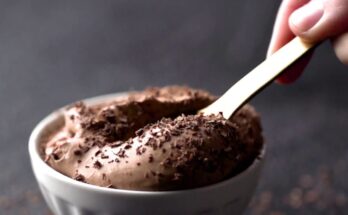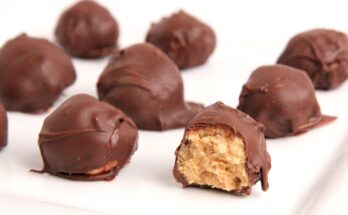Sweet Bread Recipe: Sweet bread is that comforting, aromatic, slightly sugary loaf that brings back memories of cozy kitchens and special family moments. Unlike savory bread, sweet bread is infused with ingredients like sugar, milk, eggs, and butter to give it that soft, tender crumb and golden crust we all love. It can be simple or jazzed up with raisins, cinnamon, nuts, or even a glaze on top.
This type of bread is incredibly versatile. You can enjoy it fresh out of the oven, toasted with butter, or used in dishes like bread pudding or French toast. Across different cultures, sweet bread varies a bit — think of brioche from France, panettone from Italy, or challah with a touch of sweetness. But no matter the variation, sweet bread is always a hit.
What makes sweet bread stand out is its rich flavor and tender texture. Unlike plain white or whole wheat loaves, this bread is enriched, meaning it includes fat and sugar, which not only enhances flavor but also keeps it moist longer. If you’ve ever bitten into a soft slice of homemade sweet bread, you know it’s worth every minute of preparation.
Why Make Sweet Bread at Home?
Why not just buy sweet bread from the bakery? Well, making it at home means you control every ingredient. No preservatives, no artificial flavors—just wholesome goodness made with love. Plus, there’s something incredibly satisfying about baking bread from scratch. The aroma that fills your kitchen alone is worth it.
When you bake sweet bread at home, you can also customize it to your taste. Want it sweeter? Add more sugar. Craving a cinnamon swirl? Go for it. Prefer raisins or nuts? Toss them in! You can make it gluten-free, dairy-free, or vegan if needed—completely your way.
Also, let’s not forget the therapeutic aspect of baking. Kneading dough, watching it rise, and pulling a warm, golden loaf from the oven feels like magic. Whether you’re baking for a holiday, special occasion, or just a cozy weekend treat, homemade sweet bread always delivers comfort and joy.
Ingredients You’ll Need
Basic Pantry Ingredients
Here’s your essential shopping list for a classic sweet bread recipe:
- All-purpose flour (or bread flour) – The base of the bread. Bread flour gives a slightly chewier texture due to more protein.
- Granulated sugar – Adds sweetness to the dough. Adjust based on your taste.
- Salt – A must-have to balance sweetness and enhance flavor.
- Yeast (active dry or instant) – This makes your bread rise. Make sure it’s fresh!
- Milk – Adds moisture and softness to the dough. Whole milk is best, but any milk works.
- Butter – Brings in that rich, creamy flavor. Use unsalted for better control.
- Eggs – They add richness, color, and structure to your bread.
These ingredients work together to create a soft, lightly sweet, and rich dough. The beauty of sweet bread lies in its simplicity—just a few basic items from your pantry and fridge can create something extraordinary.
Optional Add-ins for Extra Flavor
Want to level up your sweet bread? Here are some delicious add-ins:
- Raisins or dried cranberries – A traditional addition for a chewy, fruity twist.
- Chopped nuts – Walnuts, pecans, or almonds add crunch.
- Vanilla or almond extract – A little goes a long way in deepening the flavor.
- Orange or lemon zest – Brightens the flavor profile beautifully.
- Cinnamon or nutmeg – Warm spices make the bread even cozier.
You can mix these into the dough or swirl them through the center for a more visual and flavorful effect. Don’t be afraid to get creative. Your loaf, your rules.
Kitchen Tools and Equipment
Must-Have Baking Tools
To make this process smooth, having the right tools matters. Here’s what you’ll need:
- Mixing bowls – One large for dough and smaller ones for ingredients.
- Measuring cups and spoons – Accurate measurements are key in baking.
- Wooden spoon or dough whisk – Great for mixing before kneading.
- Loaf pan or baking sheet – Depending on the shape you want.
- Plastic wrap or clean towel – To cover the dough as it rises.
- Oven mitts – Safety first when handling hot pans.
Each of these plays a role in making your bread-baking experience more enjoyable. If you’re planning to bake often, consider investing in high-quality versions of these tools—they’ll pay off in the long run.
Optional But Helpful Gadgets
While you can absolutely make sweet bread by hand, these tools can save time and effort:
- Stand mixer with dough hook – Perfect for kneading if you don’t want to do it by hand.
- Kitchen scale – For more accurate ingredient measurements.
- Instant-read thermometer – Ensures your bread is perfectly baked (should read around 190–200°F inside).
- Cooling rack – Allows air to circulate and prevents soggy bottoms.
These gadgets aren’t required, but they’re nice to have—especially if you fall in love with homemade bread and want to make it often.
Preparing the Dough
Mixing the Ingredients
Start by activating your yeast. If using active dry yeast, combine it with warm milk (not hot—about 105°F to 110°F) and a teaspoon of sugar. Let it sit for about 5–10 minutes until it foams. If you’re using instant yeast, you can skip the proofing step and mix it directly into the flour.
Next, in a large bowl, whisk together the flour, sugar, and salt. In a separate bowl, beat the eggs and mix in the melted butter and vanilla (if using). Add the milk and yeast mixture to the dry ingredients, then stir in the egg mixture.
Mix until a shaggy dough forms. It’ll be a bit sticky, and that’s okay. Turn it out onto a floured surface and get ready to knead.
Kneading Techniques for Best Texture
Kneading develops gluten, which gives bread its structure. To knead, fold the dough in half toward you, push it away with the heel of your hand, rotate it, and repeat. You’ll want to do this for 8–10 minutes until the dough becomes smooth and elastic.
Not sure if it’s ready? Try the “windowpane test.” Stretch a small piece of dough—if you can stretch it thin without it tearing and see light through it, it’s kneaded enough.
You can also use a stand mixer with a dough hook for 5–6 minutes, but kneading by hand connects you more to the baking process. It’s soothing and oddly satisfying!
First Dough Rise
Creating the Perfect Environment for Rising
After kneading, shape the dough into a ball and place it in a lightly greased bowl. Cover it with a damp towel or plastic wrap. Now, it’s time to let the dough rise.
The perfect rising environment is warm and draft-free. Ideal temperature? Between 75°F and 85°F. You can use the oven (turned off, with just the light on) or place the bowl near a warm window or heating vent.
Rising is essential—it allows the yeast to ferment, which not only gives the bread airiness but also deepens the flavor. So don’t rush this step.
How Long to Let Dough Rise?
Typically, the dough needs about 1 to 2 hours to double in size. If your kitchen is cooler, it might take longer. Be patient—it’s worth it.
To test if your dough has risen enough, gently press your finger into it. If the indentation stays and doesn’t spring back, you’re good to go.
Once it’s doubled in size, it’s time to move on to shaping and the second rise.
Shaping the Dough
Punching Down and Rolling Out
After the dough has completed its first rise and doubled in size, it’s time to give it a gentle punch down. This process releases the built-up gas bubbles from fermentation, creating a more even texture in the final loaf.
Lightly flour your work surface and turn the dough out onto it. Using your hands or a rolling pin, gently flatten the dough into a rectangle. This step isn’t about flattening it completely—just giving it a more uniform shape so it’s easier to roll or braid, depending on your desired loaf style.
If you’re keeping things simple, roll the dough up tightly into a log and tuck the ends under. This helps the loaf hold its shape during the second rise and baking. If you’re feeling fancy, now is a great time to braid the dough for that classic challah look or twist it with a filling like cinnamon sugar or chocolate spread.
Adding Fillings or Toppings
This is where your creativity shines. Want cinnamon raisin bread? Sprinkle the rolled-out dough with cinnamon, sugar, and raisins before rolling it into a loaf. Prefer a nutty crunch? Add chopped nuts and honey.
Here are some popular filling ideas:
- Cinnamon-sugar swirl: Mix brown sugar, cinnamon, and a bit of butter.
- Chocolate chips or chunks: Fold them into the dough before shaping.
- Fruit and nut combo: Dried cranberries and walnuts work beautifully.
Brush the top of your shaped loaf with a little milk or beaten egg to help any toppings stick and give a beautiful golden crust.
Second Dough Rise
Why a Second Rise Matters
The second rise, also known as “proofing,” is crucial. It gives the shaped loaf time to puff up again, developing its final airy structure and soft texture. Without this step, your bread could turn out dense and underdeveloped.
Place the shaped dough in a greased loaf pan or on a parchment-lined baking sheet. Cover it loosely with a towel or plastic wrap and let it rest in a warm spot.
Tips for Timing the Second Rise
Proofing time can vary but usually takes 30 to 60 minutes. You’ll know it’s ready when the loaf has visibly puffed up and springs back slowly when lightly pressed with a finger.
Be cautious not to over-proof. If the dough rises too much, it can collapse or bake up with a wrinkled top. Keep a close eye and aim for that just-right moment when it’s puffy but still holds structure.
If your kitchen is cool, you can place the dough in a barely warm oven (turn it on for just a minute, then off) with a bowl of hot water to create humidity.
Baking Your Sweet Bread
Preheating the Oven
Now comes the exciting part—baking! Preheat your oven to 350°F (175°C). Don’t skip this step. A fully heated oven ensures your bread rises properly when it hits the heat, creating that classic domed top.
Place the loaf on the middle rack for even baking. Depending on your oven and loaf size, baking time will range from 30 to 40 minutes.
To prevent over-browning, you can tent a piece of aluminum foil over the bread during the last 10 minutes of baking. This protects the top while allowing the center to finish cooking.
Checking for Doneness
Wondering if it’s done? Here’s how to check:
- Tap test: Tap the bottom of the loaf—it should sound hollow.
- Color: Look for a deep golden-brown crust.
- Thermometer test: The internal temp should be around 190°F to 200°F.
Once baked, carefully remove the bread from the oven and let it cool in the pan for 5 minutes. Then transfer it to a cooling rack so the bottom doesn’t get soggy. It’s tempting, but wait at least 30 minutes before slicing—this allows the crumb to set properly.
Glazing and Topping Options
Make It Shine
Want your bread to look bakery-worthy? Try brushing the top with a glaze. Here are a few favorites:
- Simple sugar glaze: Mix powdered sugar with milk or lemon juice.
- Egg wash: Brush with beaten egg before baking for a shiny, golden finish.
- Honey butter: Spread on after baking for a sweet, sticky finish.
If you’re using a glaze, apply it while the bread is still slightly warm. This helps it soak in and form that irresistible crust.
Sweet and Decorative Toppings
For an extra flair, top your sweet bread with:
- Sliced almonds
- Pearl sugar
- Sprinkles (for festive loaves)
- Shredded coconut
These toppings not only add flavor and texture but also make your bread look stunning on the table.
Serving and Storing Sweet Bread
How to Serve Sweet Bread
Fresh sweet bread is best enjoyed warm or at room temperature. Slice it thick and serve with:
- Butter or honey
- Cream cheese or jam
- As French toast the next day
It also pairs beautifully with coffee or tea for a delightful breakfast or snack.
You can get creative with leftovers too—try using it in bread pudding, stuffing, or even sweet sandwiches. The flavor and texture hold up well in both sweet and savory dishes.
Storing for Freshness
To keep your sweet bread soft and fresh:
- Wrap in plastic wrap or foil and store at room temperature for up to 3 days.
- For longer storage, freeze slices individually. Wrap them in plastic and place in a freezer bag—lasts up to 3 months.
To reheat, just pop slices in the toaster or warm in the oven at 300°F for 5–10 minutes. They’ll taste just as good as freshly baked!
Variations of Sweet Bread Recipes
Cultural Twists and Flavor Ideas
Sweet bread exists in so many delightful forms around the world, and each culture adds its own unique spin. If you’re looking to experiment, here are some incredible variations to try:
- Brioche (France): Rich with butter and eggs, this classic is luxurious and fluffy. Often made into rolls or braided loaves.
- Panettone (Italy): Traditionally eaten around Christmas, it’s studded with raisins, candied citrus peel, and sometimes chocolate chips.
- Challah (Jewish tradition): While not always sweet, it can be made sweeter and is often braided with a glossy top.
- Tsoureki (Greece): A braided Easter bread flavored with orange zest and a hint of spice like mahleb.
- Conchas (Mexico): Sweet buns topped with a crumbly sugar crust in shell patterns.
Each variation offers something unique, whether it’s the shape, the spices, or the texture. Feel free to borrow ideas from these classics and make them your own.
Gluten-Free or Vegan Options
Dietary restrictions? No problem. You can still enjoy delicious sweet bread with a few swaps:
- Gluten-free flour: Use a high-quality gluten-free blend with xanthan gum for structure.
- Dairy-free milk and butter: Almond milk, oat milk, and vegan butter substitutes work great.
- Egg replacements: Try flaxseed meal (1 tbsp flax + 3 tbsp water per egg), mashed banana, or applesauce.
Keep in mind that these variations may slightly alter the texture and flavor, but with the right balance, they’re still incredibly tasty and satisfying.
Troubleshooting Common Sweet Bread Issues
Why Didn’t My Dough Rise?
There’s nothing more frustrating than dough that just won’t puff up. Here are a few common culprits:
- Dead yeast: If your yeast doesn’t foam in warm water, it’s no longer active. Always check the expiration date.
- Water too hot or too cold: Yeast is finicky. Too hot, and you kill it. Too cold, and it doesn’t activate. Aim for 105–110°F.
- Cold environment: Yeast needs warmth. If your kitchen is chilly, try placing the dough in the oven with just the light on.
Make sure your ingredients are at room temperature, and your dough should rise beautifully with a little patience.
Bread Is Too Dense or Dry
A heavy, dry loaf can be a bummer. Here’s what might’ve gone wrong:
- Under-kneaded dough: Gluten didn’t develop enough to trap air.
- Too much flour: Measuring by volume can lead to adding more flour than needed. Use a scale if possible.
- Over-baking: Check your bread 5 minutes before the timer ends. Ovens vary, and a few minutes too long can dry it out.
Next time, try adding a touch more fat (butter or oil) or reducing the flour slightly for a moister result.
Sweet Bread for Special Occasions
Holiday Treats and Celebrations
Sweet bread is the perfect treat for holidays and family gatherings. Its comforting aroma and soft, rich flavor evoke a sense of warmth and nostalgia. Try baking it for:
- Christmas: Panettone, stollen, or cinnamon swirl bread with icing.
- Easter: Colorful braided loaves or tsoureki with red eggs.
- Thanksgiving: Pumpkin spice sweet bread or maple pecan variations.
You can even shape the dough into wreaths, buns, or festive patterns to match the occasion. Add sprinkles or colored icing for a fun, celebratory twist.
Gifting Homemade Sweet Bread
Nothing says love like a homemade gift. Wrap up a loaf of sweet bread in parchment paper, tie with a ribbon, and attach a handwritten note. You can even make mini-loaves or muffins for individual gifts.
People appreciate the effort, and it’s a thoughtful way to share your baking passion with friends, neighbors, or co-workers.
Nutritional Information and Health Tips
What’s in a Slice?
A standard slice of sweet bread (depending on ingredients and size) typically contains:
| Nutrient | Amount (approx.) |
|---|---|
| Calories | 180–250 kcal |
| Carbohydrates | 25–35g |
| Sugars | 6–12g |
| Protein | 4–6g |
| Fat | 5–10g |
Of course, these numbers vary based on what you add—like chocolate, nuts, or glaze. Use less sugar and whole wheat flour for a healthier version without sacrificing flavor.
Making It Healthier Without Sacrificing Taste
If you’re watching your sugar or fat intake, here are some tweaks:
- Use honey or maple syrup instead of white sugar.
- Replace some flour with whole wheat for more fiber.
- Add mashed banana or applesauce to reduce the need for butter.
- Incorporate nuts and seeds for added protein and healthy fats.
Balanced sweet bread is not just delicious—it can also be nourishing when made with wholesome ingredients.
FAQs about Sweet Bread Recipe
Q1: What is sweet bread made of?
Sweet bread is typically made from basic baking ingredients like all-purpose flour, sugar, yeast, milk, eggs, and butter. Optional ingredients include vanilla extract, raisins, or cinnamon for added flavor.
Q2: Can I use whole wheat flour instead of all-purpose flour?
Yes, you can substitute whole wheat flour, but it will result in a denser loaf. For a lighter texture, try using half whole wheat and half all-purpose flour.
Q3: How do I make my sweet bread fluffy?
Use fresh yeast, warm (not hot) liquids, and allow the dough to rise properly. Kneading well and giving enough proofing time is key to a soft, fluffy texture.
Q4: How long does sweet bread stay fresh?
When stored in an airtight container at room temperature, sweet bread stays fresh for up to 3 days. You can also refrigerate or freeze it to extend its shelf life.
Q5: Can I add fruits or nuts to sweet bread?
Absolutely! Chopped nuts, dried fruits like raisins or cranberries, and even chocolate chips can be mixed into the dough for extra flavor and texture.
Q6: Why did my sweet bread not rise?
Common reasons include expired yeast, water that’s too hot or cold, or not allowing enough time for the dough to proof. Make sure to follow the recipe’s rising instructions carefully.
Q7: Is sweet bread the same as brioche?
While both are enriched breads, brioche is richer with more butter and eggs. Sweet bread is similar but generally lighter and less buttery.
Q8: Can I make sweet bread without a stand mixer?
Yes, you can mix and knead the dough by hand. It may take more time and effort, but the results can be just as delicious.
Conclusion
There’s something deeply satisfying about baking a loaf of sweet bread from scratch. From mixing and kneading to the intoxicating aroma as it bakes, the process itself is rewarding. And the result? A golden, tender, slightly sweet loaf that brings comfort with every bite.
Whether you’re baking for the holidays, experimenting with new flavors, or just treating yourself to a cozy afternoon at home, sweet bread is a versatile, customizable classic that never disappoints.
With this step-by-step guide, you’re well on your way to mastering sweet bread baking in your own kitchen. So roll up those sleeves, grab your ingredients, and get baking!



